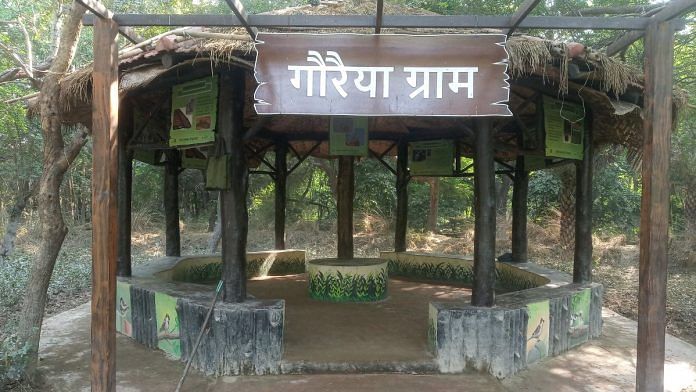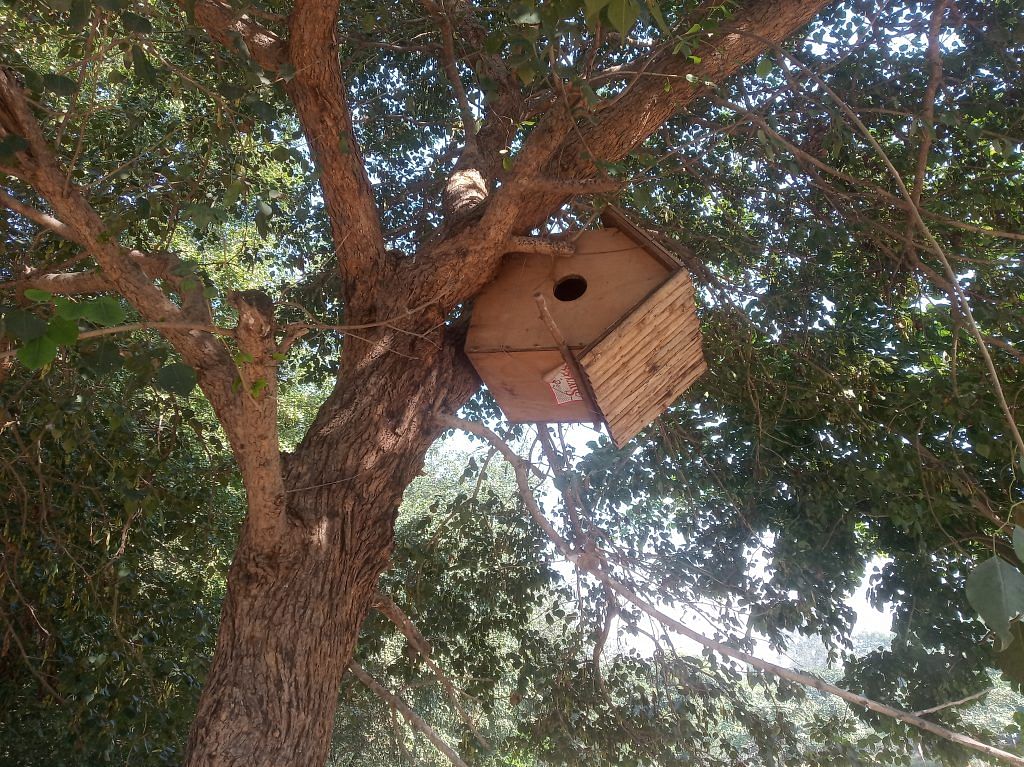
A group of tourists enters the thick 42-acre Garhi Mandu city forest, not too far from the Delhi Vidhan Sabha. They tiptoe on raised walking platforms in hushed silence, squinting at the tree tops for a glimpse of the most endangered species of India’s capital. The humble house sparrow.
It took Delhi a decade to put together a new, enabling habitat for sparrows – Goraiya Gram. And the incessant chirping of the birds hasn’t stopped since.
The wordless tunes carry the sweet sounds of hope that house sparrows will once again rule Delhi’s skyscapes. But for now, hundreds of tourists make their way to Goraiya Gram every day to see these tiny birds.
They’re building their homes in artificially created nests made from natural materials like bamboo, jute, coir, and earthen pots. It’s also the outcome of a policy that former Chief Minister Sheila Dikshit set in motion. The sparrow crisis in Delhi drew public attention during her term, and she made them the capital’s State bird in an attempt to bolster conservation efforts.
“Sparrows are an indicator of a healthy environment and are part of our ecosystem. If they disappear, then the link of nature will be broken. We have tried to recreate this habitat in Goraiya Gram,” said Sohail Madan, conservationist and assistant director of Bombay Natural History Society, which worked with the Delhi government’s forest department to create this safe haven for sparrows.
Goraiya Gram in Garhi Mandu forest, on the banks of the Yamuna, is one of the four planned ‘world class’ urban forests that the Delhi government wants to create.
But Goraiya Gram is not a zoo. “It is a dynamic habitat. We don’t want to feed the sparrows. We want to give them a habitat so that they can survive naturally,” Madan added.
The goal is to revive Delhi’s house sparrow population, and at the same time, sound an SOS so that people realise that their State bird is in danger of becoming extinct.
Also read: Dogs are millionaires in Gujarat village. Thank the Mughals
The importance of creepy-crawlies
But to create a forest for sparrows is easier said than done. The tiny brown, grey, and white avian is neither a jungle bird nor a predator on wings. It’s a village bird that needs a safe nest and a steady supply of pesticide-free caterpillars, worms, and other insects to feed on.
The nests are a priority, and it is Samantara Devi’s job to make sure that the sparrows have plenty of homes. She helps arrange and maintain the nests and has been living with her family at Garhi Mandu for the last two years.
“When we first came, we could hear a faint sound, but now, due to the increase in the number of sparrows, the sound has also increased. If the nests fall in a strong wind, we put them back again,” Devi said.
Nests alone will not guarantee the presence of numbers. If the insects disappear, so will the sparrows. And so their village has two ‘insect hostels’ that offer a buffet of creepy-crawlies for the birds to feast on.
These hostels hold waste products such as broken tiles, paper from old magazines, and packaging material to provide proper living quarters for a variety of insects.
When Delhi’s Environment Minister Gopal Rai inaugurated the sparrow village in May this year, he said it was “a good beginning” to protect the State bird. We do not only want to increase the green cover in Delhi but also create a healthy ecological system and give a suitable environment to birds and animals.”
Conservationists have also planted native berries like karonda and kundi and stocked feeder boxes. They’ve erected bamboo shelters that offer safe spaces during storms and heavy rains. And a gardener fills a water bath every day.
For human visitors, there’s a herbal garden with tulsi, aloe vera, patharchatta, ajwain, and other medicinal plants. People can take the free saplings home.
Other insects, birds, and animals, including peacocks, wild boars, nilgai, parrots, squirrels, and butterflies, are also thriving in the forest.
But there’s another bird that has discovered the village—the wild pigeon, which has been blamed for declining sparrow numbers in cities. Madan, though, doesn’t cast any one species as a villain. It’s part of the dynamic flux of nature, he argues, reiterating that Goraiya Gram is not a zoo.
Predatory birds like the pigeon aren’t the only reason for the sparrow’s decline. Loss of habitat due to urbanisation, rising pollution levels, increasing use of insecticides, and even residents’ preference for ornamental trees and shrubs that make it difficult for sparrows to nest and breed in have also played a role. Today, the sparrow is on the Red List of the International Union for Conservation of Nature’s endangered species.
But in the heart of Goraiya Gram, it’s hard to imagine how threatened sparrows are. They flit from twig to twig and tree to bush, chirping away in a frenzy.
They are the reason why Harbir Singh wakes up with a smile on his face. The gardener at the sparrow village lies back on his cot in calm satisfaction. “They’ve come back. They need a place to lay their eggs, and they now have their own homes where they can live safely. Earlier, they were not even visible, but now they can be seen clearly,” said Singh, who has been working in the forest of Garhi Mandu for more than 20 years.
There was a time when the urban forest was farmland used by residents of Usmanpur village. But the DDA transferred the land to the Forest Department, after which, in 2003, a systematic forest area was created by fencing the entire region.
“Garhi Mandu is one of the new and pristine forests of Delhi, situated near the densely populated area of Northeast district. This forest area has a sizeable amount of flora and fauna,” said Chestha Singh, deputy conservator of forests, central division.
Dipak, who lives in Usmanpur village nearby, stops his bullock cart outside the sparrow village to listen to the birds. “We grew up with sparrows, but they were declining. This conservation drive makes us feel good,” he said, sitting atop his bullock cart.
Also read: Bengaluru Batman fights bribes, writes FIRs, calls NGOs. Broseph on Reddit is Mr Fixit
The mission to conservation
Nobody realised that the sparrow was in danger until its little, strident chirps were drowned out by the cacophony of caws and coos from crows and pigeons. While the nation’s gaze was on the majestic tiger, sparrows started vanishing one by one from Bengaluru, Mumbai, Delhi, Haryana, Lucknow, and other cities across India.
But in Nashik, Mohammed Dilawar, now 42 years old, realised what was happening. He had seen the vultures disappear before his eyes. Dilawar made it his mission to save the sparrow. He founded the Nature Forever Society in 2005.
“In the early stages, no one thought about the conservation of sparrows. At that time, conservation was focused all around tigers. It was very difficult for us to convince the scientific community. They were very rigid and blatantly denied that sparrows were declining,” said Dilawar, who started a movement to create more awareness programmes among citizens.

He later launched the ‘Rise of Sparrows’ campaign in collaboration with Delhi government in 2012, and is one of the 30 Heroes of the Environment chosen by Time Magazine in 2008.
But sparrows were disappearing in London and cities in North America and Europe. And more people started paying attention to the little bird.
By 2010, Dilawar’s persistent efforts caught the attention of Delhi CM Sheila Dikshit. He requested Dikshit to celebrate the first World Sparrow Day on 20 March, which she accepted and celebrated at her residence.
Sheila Dikshit was very fond of sparrows, so she herself got nests for this little bird at her official residence on Motilal Nehru Marg and started its conservation from her home in the state, said Dilawar, who set up the nests at her residence.
“She was very passionate about sparrows and was one of our strongest sparrow supporters. That was very helpful in our early stage. It took us more than a year to get the bird declared the State bird of Delhi. Her genuine love and concern for the sparrows made this possible,” Dilawar said.
In 2012, on the eve of Independence Day and at the launch of the ‘Rise for Sparrow’ campaign, the house sparrow was declared the State bird of Delhi.
Sparrow also makes a rare appearance on postal stamps issued in 2010.
The NFS suggested a ban on exotic plants on all government and corporate campuses as well as the construction of buildings with glass exteriors. But these suggestions have not been implemented, said Dilawar. Conservation efforts took a backseat to the red tape culture and transition of governments around 2013, when the Aam Aadmi Party came into power in Delhi.
But in 2020, during the pandemic, things changed. Forest department officials approached the BNHS to help create the sparrow village. “The whole project started during Covid. The government officials had a positive approach. There were a lot of meetings held before setting up the sparrow village,” Madan added.
Also read: Heels, Senorita mocktails, kebabs—Gumbad Cafe is a bit of South Delhi in Old Delhi
Need for a survey
If “hope is the thing with feathers that perches in the soul,” then the house sparrow is a symbol of resilience. Ten years after it was made the State bird, its numbers are believed to be slowly rising in some cities in India.
Earlier this year, in March, the Salem Ornithological Foundation, after conducting a state-wide survey, declared that Tamil Nadu’s sparrow population is now stable. In Delhi, too, birders say they are seeing more sparrows in the city, though a survey has yet to be conducted.
A baseline survey was scheduled to count the number of sparrows, but due to the unexpected flood in September, it was halted. But by next year, counting will be done to establish the impact of conservation efforts, said a forest official.
It shows that grassroots conservation efforts can have an impact.
“We push people to adopt nest boxes and bird feeders, and through this, a dil ka rishta (emotional connection) has been made with the sparrows, and love for them will grow,” Dilawar said.
(Edited by Tarannum Khan)

COMMENTS